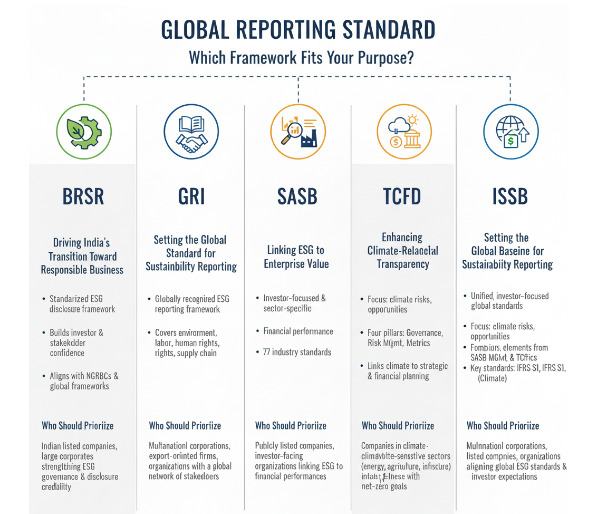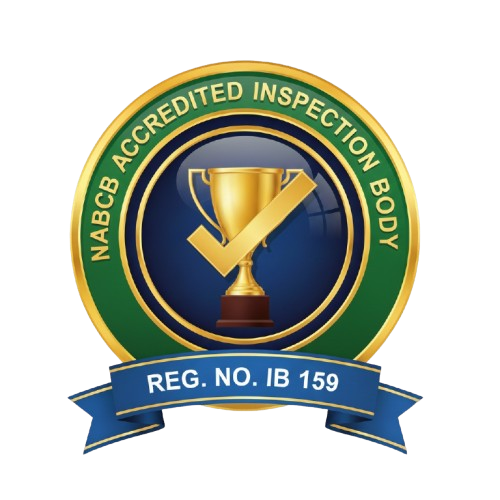ESG Reporting Frameworks Explained: How to Choose the Right One (BRSR, GRI, SASB, TCFD, ISSB)

Hygiene Ratings: The New Standard of Dining
- November 18, 2025
- Sathyapriya M
It started with a question every sustainability professional has asked at least once:
“With so many ESG frameworks around the world — which one truly fits our organization?”
Today’s ESG landscape can feel like an alphabet soup—BRSR, GRI, SASB, TCFD, ISSB—all promising transparency, accountability, and global alignment. The real challenge for businesses isn’t whether to report ESG data—it’s how to report it meaningfully to create value for investors, regulators, and communities. Let’s break it down.
In this guide, we compare the world’s leading ESG reporting frameworks — BRSR, GRI, SASB, TCFD, and ISSB — explaining their purpose, benefits, and ideal use cases. Whether you’re reporting for regulatory compliance, investor expectations, or global benchmarking, this breakdown will help you choose the right ESG framework for your organization.
BRSR Framework: India’s Leading ESG Reporting Standard for Businesses
Corporate India once struggled to showcase its sustainability efforts, with scattered CSR reports providing little clarity on real impact. Then SEBI introduced the Business Responsibility and Sustainability Report (BRSR), changing the game.
Sustainability became an integral part of business strategy, directly linked to performance, stakeholder trust, and long-term value. Based on the National Guidelines on Responsible Business Conduct (NGRBC), BRSR helps companies focus on ethical governance, inclusivity, human rights, and environmental stewardship, turning intentions into measurable, credible outcomes.
Why BRSR Matters for ESG Compliance and Responsible Business Conduct
- Standardized ESG disclosure framework for listed Indian companies, ensuring transparency and comparability.
- Builds investor and stakeholder confidence by demonstrating responsible business practices aligned with global sustainability expectations.
- Encourages data-driven sustainability, helping companies measure and manage impacts on the environment, workforce, supply chains, and society.
- Aligns with global ESG frameworks like GRI, SASB, and TCFD, enabling Indian businesses to communicate in a global sustainability language.
Who Should Use the BRSR Framework for Sustainability Reporting
Indian listed companies, large corporates, and enterprises aiming to strengthen ESG governance, disclosure credibility, and alignment with SEBI’s sustainability mandate.
💡 Insight Worth Noting:
Since SEBI’s introduction of mandatory BRSR reporting, adoption among India’s top 1,000 listed companies has soared from around 20% in FY 2021 to over 75% in FY 2024. ESG has moved far beyond being a compliance exercise — it’s now shaping how businesses build trust, attract capital, and stay competitive in a changing world.
GRI Standards: The Global Benchmark for Sustainability and ESG Disclosure
Sustainability once hid in CSR reports The Global Reporting Initiative (GRI) changed the game, giving businesses a structured, globally recognized framework to tell their ESG story.
GRI enables companies to measure and report environmental footprint, labor practices, human rights, supply chain responsibility, and community impact—turning ESG actions into measurable, stakeholder-relevant outcomes. It bridges the gap between operational impact and stakeholder expectations, building credibility, transparency, and long-term value.
Why GRI Is Essential for Transparent and Credible ESG Reporting
- Provides a globally recognized ESG reporting framework for benchmarking across industries.
- Enables companies to communicate ESG performance clearly to investors, regulators, employees, and communities.
- Supports data-driven sustainability strategies for measurable impact and continuous improvement.
💡 Insight Worth Noting:
GRI standards are used by over 10,000 organizations across 100+ countries, demonstrating that structured, transparent, and globally aligned ESG reporting is critical for credibility, stakeholder trust, and long-term business value.
Ideal Organizations for GRI Sustainability Reporting
Multinational corporations, export-oriented firms, and organizations that engage with a global network of stakeholders — investors, customers, and supply chains.
SASB Standards: Industry-Specific ESG Reporting for Financial Materiality
Before SASB, ESG reporting often lacked financial relevance. The Sustainability Accounting Standards Board (SASB) solves this by focusing on sector-specific, financially material ESG issues that affect enterprise value.
SASB guides companies to report ESG factors relevant to their industry—energy efficiency in manufacturing, data privacy in tech, governance in finance—linking sustainability performance to financial outcomes.
Why SASB Matters for Investor-Focused ESG Disclosures
- Provides investor-focused ESG reporting aligned with financial decision-making.
- Helps publicly listed companies integrate sustainability data into annual reports and filings.
- Bridges the gap between responsible practices and long-term value creation.
💡 Insight Worth Noting:
SASB standards are used by thousands of publicly listed companies worldwide, highlighting that investor-focused, financially material ESG reporting is essential for credibility, guiding investment decisions, and driving long-term enterprise value.
Who Should Prioritize SASB for ESG and Financial Reporting
Publicly listed companies, investor-facing organizations, and businesses seeking to link ESG reporting with financial performance.
TCFD Framework: Climate Risk Reporting for Strategic and Financial Transparency
The Task Force on Climate-related Financial Disclosures (TCFD) helps businesses disclose climate risks, opportunities, and resilience strategies. It uses four pillars—governance, strategy, risk management, and metrics & targets—linking climate considerations directly to strategic and financial planning.
Why TCFD Is Critical for Climate-Related ESG Disclosures
- Provides a globally recognized framework for climate-related financial reporting.
- Helps companies link climate risks and opportunities to strategy and financial performance.
- Enables investors and stakeholders to assess climate resilience and long-term value creation.
💡 Insight Worth Noting:
Companies following TCFD guidelines have improved climate risk disclosure, enabling investors to make more informed decisions. Adoption is increasing globally, reflecting that climate transparency is a strategic business imperative.
Industries That Should Adopt TCFD for Climate Risk Reporting
Companies in climate-sensitive sectors — such as energy, finance, manufacturing, agriculture, infrastructure, and transport — as well as those pursuing net-zero or decarbonization goals.
ISSB Standards: The Global Baseline for Unified Sustainability Reporting
The International Sustainability Standards Board (ISSB), established by the IFRS Foundation, is not a reporting format or template — it’s a unified global framework that defines what sustainability information should be disclosed, how it connects with financial reporting, and why it matters to investors and regulators.
While many organizations once struggled with multiple ESG frameworks — like SASB, TCFD, GRI, and CDP — the ISSB brings clarity and alignment. It consolidates the best elements of SASB’s industry-specific metrics and TCFD’s climate-risk structure into a single, globally recognized standard that aims to make sustainability disclosures:
✅ Consistent across markets
✅ Comparable across industries
✅ Decision-useful for investors
It guides what sustainability-related information companies must disclose and how it links to financial performance — but it doesn’t prescribe the visual layout or structure of the report.
The two key standards define the foundation:
🔹IFRS S1 – General Requirements: Defines how organizations disclose sustainability risks and opportunities that impact enterprise value, forming the foundation for consistent, investor-focused reporting.
🔹IFRS S2 – Climate-related Disclosures: Focuses on climate-specific risks and opportunities, aligning with TCFD pillars — governance, strategy, risk management, and metrics & targets — to integrate climate impact into financial decision-making.
Together, these standards help organizations embed sustainability into financial decision-making — moving ESG reporting from a narrative exercise to a strategic, investor-relevant disclosure system.
Why ISSB Is Transforming Global ESG Reporting Standards
- Unifies ESG frameworks – Reduces confusion from multiple reporting systems.
- Links sustainability to value – Treats climate and social factors as financial drivers.
- Promotes accountability – Strengthens governance and leadership transparency.
- Drives global alignment – Countries worldwide are adopting ISSB-based disclosure standards.
Who Should Adopt ISSB for Consistent, Investor-Focused ESG Reporting
Multinational corporations, listed companies, and organizations looking to align with global ESG standards, improve reporting consistency, and meet investor expectations.
Choosing the Best ESG Framework: Strategic Alignment for Maximum Business Value
Choosing the right ESG framework is no longer optional—it’s strategic. BRSR leads for Indian companies, GRI for global benchmarking, SASB for investor relevance, TCFD for climate risk transparency, and ISSB for globally harmonized ESG reporting. Understanding the purpose, benefits, and audience for each framework ensures your ESG reporting creates real business value.

Post Tags :
About Us
We are a team of certified professionals with expertise in green audits and Hygiene Rating Audits, driven by industry standards and sustainability best practices. Our comprehensive inspection services help institutions and businesses improve environmental performance, enhance hygiene compliance, and align with national and global standards.





